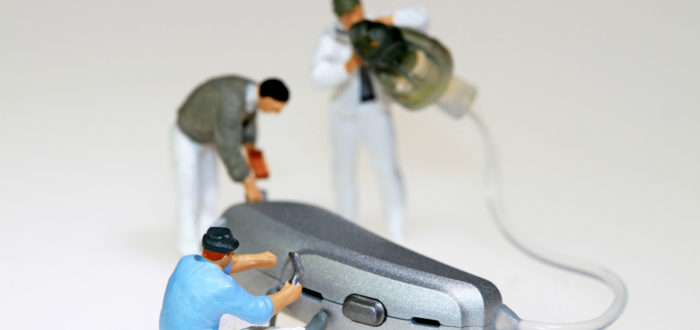If you are one of the millions who utilize the help of hearing aids or other hearing devices, knowing how to maintain and troubleshoot your device when you have an issue is important.
Proper maintenance and care can help you reach optimum hearing potential and will help your device last longer. While you always have the option to take or send your device in for servicing, knowing how to adjust it yourself can be beneficial and save you time and money.
Today, we’re exploring the most common hearing aid repairs. Learn when you may be able to troubleshoot the issue yourself at home, and when you need to visit your local hearing clinic.
What Hearing Aid Repairs Happen Most Frequently?
Hearing aids are complex devices with several components that can malfunction. The most common hearing aid repairs include:
Battery Compartment
The battery compartment is one of the most frequently repaired parts of a hearing aid. Over time, the battery compartment may wear out or become damaged, causing the battery to lose contact with the hearing aid and not work properly.
Microphone
The microphone is responsible for picking up sound and transmitting it to the hearing aid. If the microphone becomes clogged or damaged, it may stop working and need to be replaced.
Receiver
The receiver is responsible for amplifying the sound and sending it to the ear. If the receiver becomes damaged, it may cause a loss of sound quality or volume, and need to be replaced.
Volume Control
The volume control is responsible for adjusting the volume of the hearing aid. If the volume control becomes damaged, it may cause the volume to be too loud or too soft, and need to be repaired.
Wax Guard
The wax guard is responsible for keeping earwax out of the hearing aid. If the wax guard becomes clogged with earwax, it may cause the hearing aid to stop working, and need to be cleaned or replaced.
Earwax Blockage
Over time, earwax can accumulate in the hearing aid and cause a blockage. This blockage can cause the hearing aid to stop working, and need to be cleaned or replaced.
Dead Battery
Hearing aids rely on small batteries that can run out of power. If a hearing aid battery dies, the hearing aid will stop working, and a new battery will need to be installed.
Water Damage
Hearing aids are not waterproof and can be damaged by exposure to water. If a hearing aid becomes water damaged, it may stop working and need to be repaired.
Troubleshooting Common Problems With Hearing Aids
Now that you understand the most common hearing aid repairs, let’s look at potential troubleshooting you can do at home:
✓ Check to see if the battery is in correctly. You should be able to close the door easily, at which point the aid should switch on.Is the battery in correctly? You should be able to close the door easily, at which point the aid should switch on.
✓ Try replacing the battery.
✓ Check the mold, dome, tubing and microphone for any waxy blockage or moisture.
✓ Do you have the volume at the correct setting? Make sure it’s not set too low.
✓ Do you have the hearing aid on the correct program and / or setting?
✓ Does the device appear damaged? Is the tubing cracked or squashed? If you suspect that the device is damaged, we recommend booking an appointment with the team.
Need Help? Have a Question? Contact Us Today!
If you’d like to book an appointment with our hearing specialists, we’d be happy to give your hearing aids a quick check over. Book your appointment with the team at Regional Hearing & Balance by calling us at 208-497-3596. Alternatively, click here to book a complimentary hearing assessment.


Recent Comments